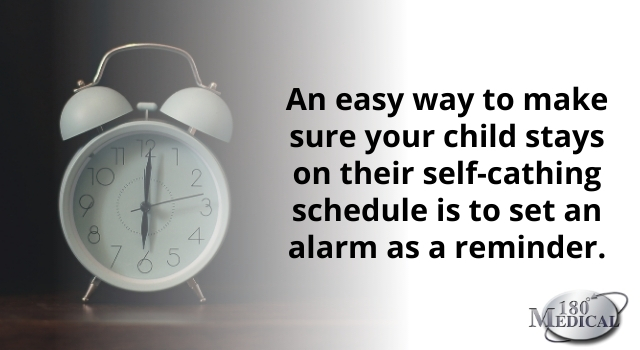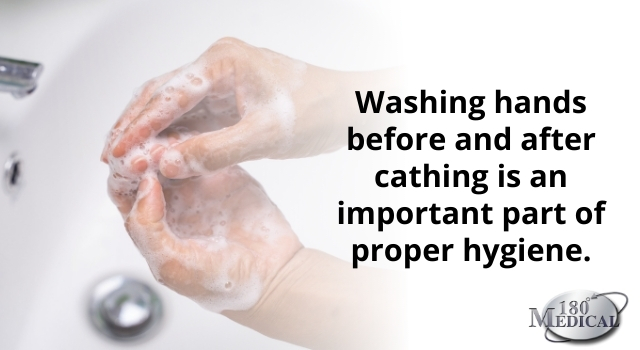
Do you have questions about how to help your child learn to self-catheterize? Are they at an age when they’re ready to begin handling their own bladder management program with intermittent catheters? I have some helpful tips from a firsthand perspective as someone who was born with spina bifida.
My name is Brendan, and I’m a Patient Advocate at 180 Medical. In my role, I often speak firsthand with families and caregivers of children who need to use catheters.
Throughout my life, I’ve often been asked what tips I’d give a family with a child who needs to learn to use catheters independently. Honestly, it can be hard to give personalized tips because each of us has our unique anatomy and situation. What works for one person may or may not work for the next.
However, I believe anybody can accomplish anything if we break it down into steps. Then, we must take those necessary steps and follow through. So, for me, this all comes down to these three steps: Creating a Cathing Plan, Commitment and Compliance, and Confidence.
Create a Cathing Plan to Help Your Child Learn to Self-Catheterize
First, we should review the basics, such as getting a prescription and making a catheterization schedule that feels doable.
Tip 1. First, see your child’s doctor.
Because catheters are prescription-only medical devices, start by seeing a doctor if you haven’t already. They can tell you how many times per day your child should cath as well as what size catheter to use. Plus, they can go over the process of how to use catheters together with you and your child.

Once you get home, if you need more step-by-step instructions for learning how to self-catheterize, 180 Medical offers free online pediatric catheterization instructions.
If you’re unsure if your child is ready to learn to self-catheterize, our blog post, Is Your Child Ready to Learn to Self-Cath?, has some helpful tips from Registered Nurse Louisa Salvin.
Tip 2. Normalize the process of cathing.
I completely understand how unfair it can feel to learn that sometimes those of us with disabilities have to do something others do not, such as a bowel and bladder management program.
A friend of mine recently said it perfectly, “When you’re a kid, the last thing you want is to be different, and living with a disability puts your difference on constant display for everybody to see.” When we’re told we also have to use a catheter, it’s just one more difference we have to face.
I always like to say that although living with a disability can be challenging, I know I’m not the only one who faces daily challenges. I believe how we choose to respond to these challenges ultimately shows our character and impacts our quality of life.
Your child is facing a challenge in learning how to self-catheterize. Support them by keeping an open line of communication and letting them know they’re not alone.
Also, the 180 Medical Kids Club is a great way to help normalize the cathing process for your child.
Tip 3. Make a self-catheterization schedule and set reminders.
After getting a prescription, create a schedule for cathing at certain times of the day every day. You’ll want to base this on the prescribed number of times per day your child should cath.
Some parents and caregivers like to set an alarm on their child’s watch or phone. Having automatic reminders like this is an easy way to make sure your child always knows when it’s time to go to the bathroom.

Tip 4. Plan in advance for when your child is at school.
When I’m talking to families about their children learning to self-catheterize, it’s the part about using catheters at school or away from home that seems to be the most challenging. However, it’s still very doable.
If your child is going to school, communicate their needs with their teacher and/or their school nurse. They can make accommodations, such as storing your child’s catheter supplies privately. This keeps your child from having to carry their supplies around all day.
Personally, when I was in elementary school, I was able to use the restroom at the school nurse’s office. This is where I also stored my supplies so I wouldn’t have to carry them around all the time or have my friends see them. That simple step made me feel more confident in handling my own program at school. Plus, an added bonus of that arrangement is that it gave my parents some control because the nurse would update them if I wasn’t following through on my self-catheterization program.
Commitment and Compliance
The next step is to reinforce your plan with the importance of commitment and compliance. By doing this, you and your child may find that self-catheterizing will become easier over time. You may even notice that fewer accidents occur as your child gets used to self-cathing on a schedule.
However, to make that happen, you both have to make an honest effort to follow the prescribed cathing plan. Remember, kids can easily get sidetracked at school or a friend’s house. If they get distracted, they may neglect their self-cathing routine.
Tip 4. Emphasize the importance of a hygienic self-catheterization schedule.
When living with a spinal cord injury, neurogenic bladder, spina bifida, or another condition affecting the bladder, self-catheterization is often one of the things we must do to ensure we are able to live the most independent and healthy lifestyle possible. It may not be the only routine we need to follow each day, but it is one of the more significant ones.
If we fail to follow our self-catheterization program, we put ourselves at risk for consequences that we don’t want to experience, such as urinary tract infections or UTIs and extra doctor’s office visits. In some cases, it could even lead to more severe consequences like hospital stays and surgery.
As you help your child learn to self-catheterize, go over each step together until they’ve got it down. This includes practicing good hygiene, which is a very important part of the responsibility of handling their own self-cathing routine.

They should always wash their hands well with warm water and soap before handling their catheter or starting to self-cath. Practicing proper hygiene can help reduce the risk of urinary tract infections (UTIs) and other related complications.
Also, you might want to make sure they have hand sanitizer and/or disposable gloves just in case.
Tip 5. Address any concerns or issues your child may be having.
As your child adjusts to the new routine of self-cathing, it’s normal to hit some snags or bumps in the road. You might hear some complaints like “My friends will know” or “Cathing takes forever.”
Assure your kid that their friends don’t have to know unless they decide to tell them. They don’t have to tell anybody about their personal needs. However, if your child chooses to share that information with a friend, let them know that any good friend will understand and care that this process is what keeps you healthy.
If they feel that self-cathing takes too long, I like to say, “What takes longer? Taking a few minutes to use a catheter, or having to go clean up after an accident because you didn’t cath?” In other words, nobody keeps track of how long you’re in the restroom, but they may notice if you have an accident and have to go spend time cleaning up.

To the parents and caregivers out there, be honest with your kids that cathing is a different routine they just have to do. Never sugarcoat the importance of making sure they follow the program. As kids, we all know recognize when our parents mean what they say, so consistency is important.
Early on, there will be accidents, some forgetfulness, and maybe even a little stubbornness. However, if you stay committed to the program, so will your kid.
Finding Confidence
Finally, comes the best step of all, which is Confidence.
Following the first 2 steps will lead to confidence as the consistent worry about accidents starts to minimize. As every adult with a disability will tell you, accidents are just another part of the deal when living with a disability.
However, by putting forth honest effort in your bowel and bladder management programs, you can definitely lower your frequency of such situations happening. This will allow you to spend more time experiencing all life has to offer.
It’s all about making a commitment to follow the plan that best suits your health.
Where to Buy Pediatric Catheters
Are you ready to buy pediatric catheter supplies for your child? Do you need instructional materials that may help your child learn to self-catheterize? 180 Medical can help you with this and more as your trusted partner for your child’s catheterization needs.
With nearly 2 decades of experience in helping customers as young as newborns, we understand that what works for one individual will not always work for another. Our trained Product Specialists are happy to help find the right pediatric catheters and/or incontinence supplies for your child. Contact 180 Medical today to get started!
Disclaimer: Please note that this is intended to provide a general understanding of self-catheterization. It should not be used in place of a visit, call, or consultation with a physician or other healthcare provider.

